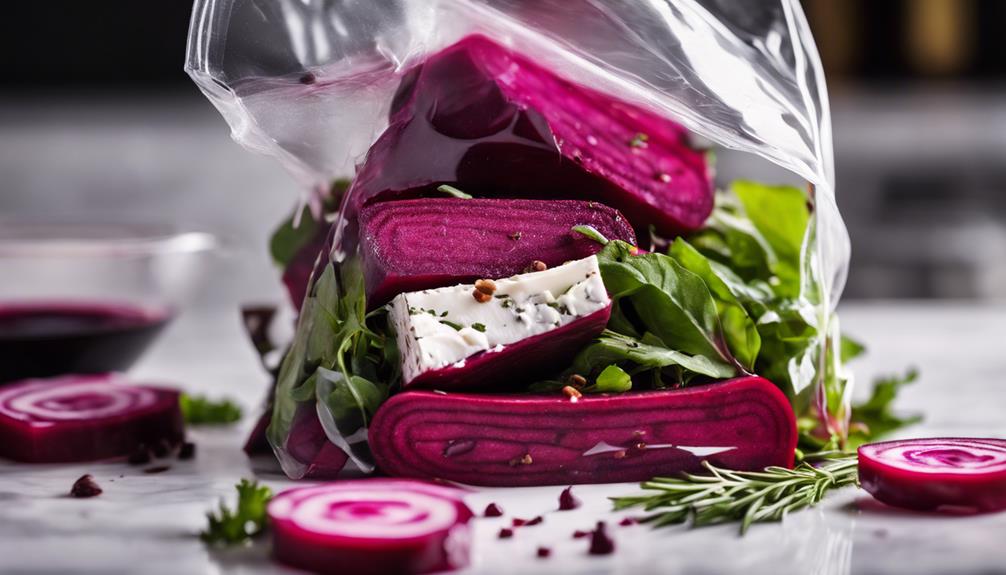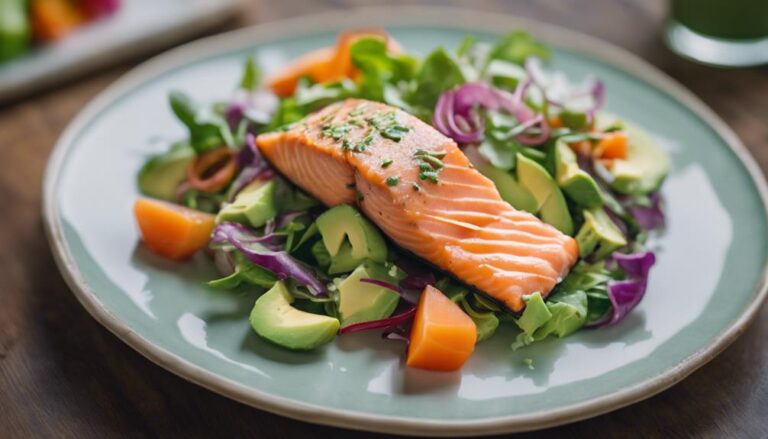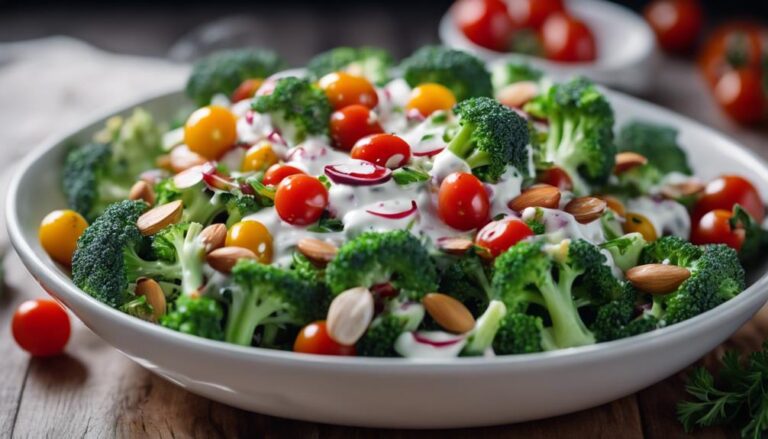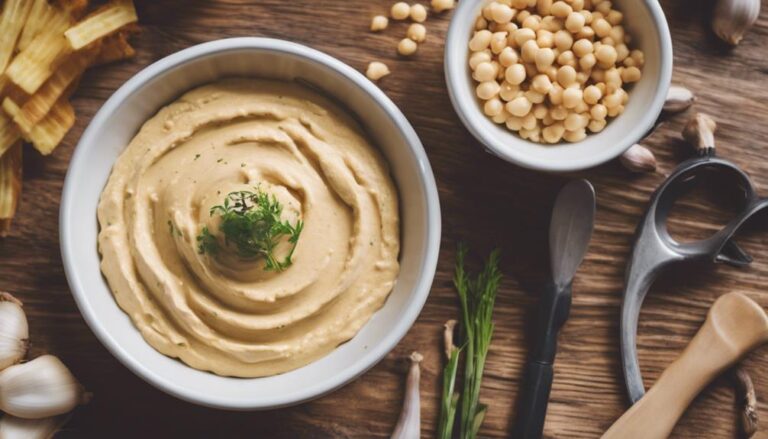Sous Vide Beet and Goat Cheese Salad
To create a delicious sous vide beet and goat cheese salad, set the water bath to 183°F (84°C) for tender beets. Cook the beets at this temperature for 1.5 to 2 hours for vibrant color and flavor. Guarantee the goat cheese maintains a creamy consistency at 122°F (50°C). Experiment with different cheeses for varied tastes. Precision cooking techniques ensure consistent results. The earthy sweetness of beets pairs well with the tangy richness of goat cheese. For more insights on enhancing your salad with texture contrasts and complementary flavors, explore further details in the provided research.
What You Will Learn Here
- Sous vide beets at 183°F for 1.5-2 hours for vibrant color.
- Maintain goat cheese at 122°F for creamy consistency.
- Pair tender beets with tangy goat cheese.
- Experiment with textures like nuts for depth.
- Use acidic vinaigrette to balance richness of cheese.
Beet's Origins
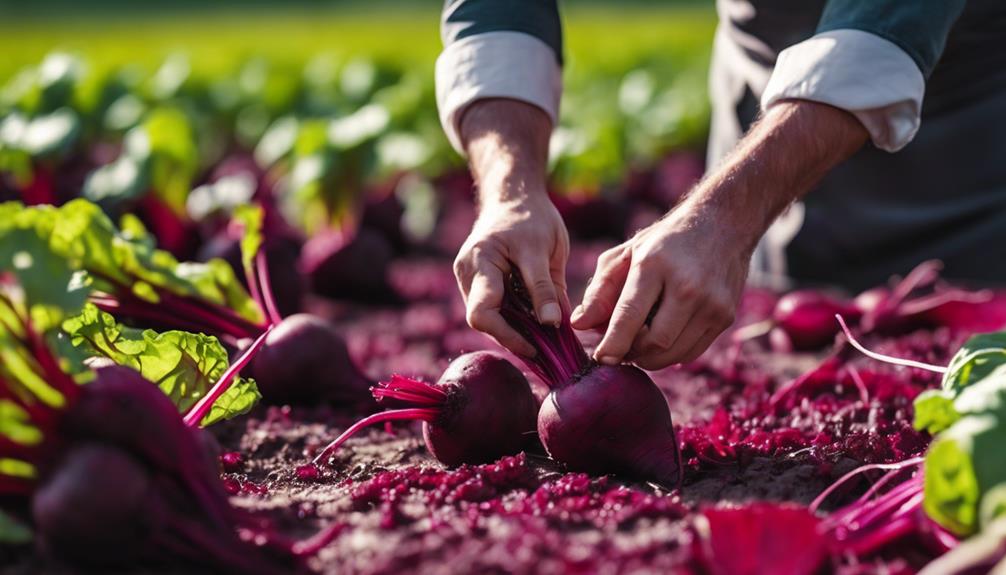
Beets have a rich ancient history, dating back to civilizations like the Egyptians and the Romans. Today, there are various beet varieties, each with unique colors and flavors.
In culinary practices, beets are used in a wide range of dishes, from salads to soups, adding a sweet and earthy taste to the plate.
Beet's Ancient History
Having originated in the Mediterranean region, beets have a long and storied history dating back to ancient times. Beet cultivation can be traced back to civilizations like the Egyptians, who not only grew beets for consumption but also utilized them for their medicinal properties. These vibrant root vegetables were valued for their nutritional benefits, containing essential vitamins and minerals such as vitamin C, potassium, and fiber.
In ancient Rome, beets were a popular vegetable enjoyed by both the affluent and the common people. They were often served roasted or boiled and seasoned with herbs and spices. The cultivation of beets spread throughout Europe during the Middle Ages, with different varieties emerging over time. Beets became a staple in many diets due to their versatility and long shelf life.
The historical significance of beets extends beyond their culinary uses. In ancient times, beets were also used for dyeing fabrics and as offerings to the gods in religious ceremonies. This rich history showcases the enduring importance of beets in various aspects of human civilization.
Beet Varieties Today
With their ancient roots firmly established, exploring the diverse range of beet varieties available today offers a glimpse into the evolution of this versatile vegetable. Beet farming has led to the cultivation of an array of beet colors, from the classic deep red to golden, candy-striped, and even white varieties. Each color not only adds visual appeal but also indicates different nutritional benefits. Red beets contain antioxidants like betalains, while golden beets offer a milder taste and less staining potential.
Beyond color, beet flavor profiles vary widely. Some beets have a sweeter taste, ideal for roasting or incorporating into desserts, while others boast earthier notes that shine in savory dishes like salads or soups. Nutrient-rich and low in calories, beets provide essential vitamins and minerals such as folate, potassium, and fiber, making them a healthy addition to any diet.
Experimenting with different beet varieties can enhance your culinary creations, adding vibrant colors, unique flavors, and nutritional benefits to your dishes.
Beet's Culinary Uses
Uncovering the culinary origins of beets reveals a rich history of diverse culinary uses and versatile applications in various cuisines worldwide. Beets have been utilized in a multitude of ways, from savory dishes to sweet treats. In addition to being a staple in salads and soups, beets have found their way into unique culinary creations such as beet cocktails and beet desserts.
Beet cocktails have gained popularity for their vibrant color and earthy flavor profile. Mixologists incorporate beet juice or beet-infused spirits to add a touch of sweetness and a hint of earthiness to cocktails, creating a visually appealing and flavorful beverage.
When it comes to desserts, beets offer a natural sweetness and a beautiful hue that can elevate traditional sweet treats. Beet desserts like beet cake, beet brownies, and beet ice cream showcase the vegetable's versatility in the domain of sweets, providing a unique and nutritious twist to classic desserts. Whether roasted, pickled, or pureed, beets bring a delightful sweetness and earthy undertones to a wide array of culinary creations.
Beet Varieties
When exploring beet varieties, it's important to take into account their unique flavors and textures to elevate your culinary creations.
- Red Beets: These are the most common variety, known for their deep red color and earthy flavor. They're versatile and work well in both sweet and savory dishes, such as beet salads and borscht soup.
- Golden Beets: With a milder taste than red beets, golden beets offer a sweeter flavor profile and a vibrant yellow hue. They're a great addition to salads, roasts, or pickling recipes.
- Chioggia Beets: Also called candy cane or striped beets, Chioggia beets have a stunning pink and white striped interior. They've a slightly sweeter taste compared to red beets and can be enjoyed raw in salads or roasted for a colorful side dish.
Each beet variety brings its own unique qualities to the table, allowing you to experiment and create diverse dishes that showcase the beauty and flavors of these root vegetables.
Beet and Goat Cheese Pairings
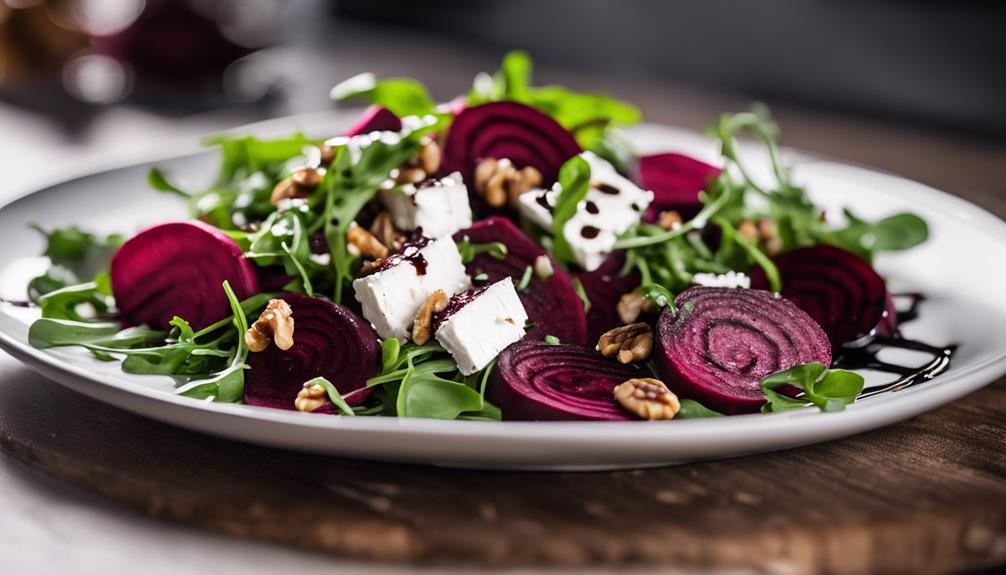
When it comes to beet and goat cheese pairings, there are a few standout options worth exploring.
You can try the elegant Sous Vide Beet Salad, the indulgent Goat Cheese Stuffed Beets, or the delightful Beet and Goat Cheese Tartlets.
These pairings showcase the versatile and complementary flavors of beets and goat cheese, offering a range of tastes to suit different preferences.
Sous Vide Beet Salad
Enhance the earthy sweetness of beets with the creamy tang of goat cheese in this delightful sous vide salad.
- Flavor infusion: Sous vide cooking allows the beets to absorb the flavors of herbs and seasonings, intensifying their natural taste and creating a harmonious blend with the goat cheese.
- Texture control: By cooking the beets sous vide, you can control the firmness of the beets, ensuring they're tender yet retain a pleasant bite that contrasts beautifully with the creamy goat cheese.
- Perfect pairing: The marriage of sous vide beets with goat cheese is a match made in culinary heaven. The earthiness of the beets complements the tangy richness of the goat cheese, creating a balanced and flavorful salad that's sure to impress your taste buds.
Sous vide beet salad offers a sophisticated yet straightforward dish that highlights the best qualities of both ingredients. Try this combination for a culinary experience that showcases the versatility and deliciousness of beets and goat cheese.
Goat Cheese Stuffed Beets
To create flavorful and creamy Goat Cheese Stuffed Beets, you can infuse the earthy beets with tangy goat cheese for a delightful culinary pairing.
- Roasted beets and creamy goat cheese: Begin by roasting beets until tender, then hollow out the center slightly to make room for a generous dollop of creamy goat cheese. This combination offers a perfect balance of sweet and tangy flavors.
- Beetroot recipes featuring cheese pairing: Goat cheese is a versatile ingredient that pairs exceptionally well with the earthy sweetness of beets. Whether you're making salads, tarts, or even pasta dishes, incorporating goat cheese into beet recipes can elevate the dish to new heights.
- Experiment with different cheeses: While goat cheese is a popular choice, don't be afraid to experiment with other cheese varieties like feta or blue cheese. Each cheese brings its unique flavor profile to the dish, allowing you to customize your beet and cheese pairings to suit your taste preferences.
Beet and Goat Cheese Tartlets
Infusing flaky pastry with the earthy sweetness of beets and the tangy creaminess of goat cheese creates irresistible Beet and Goat Cheese Tartlets.
- Tartlet variations, Flavor combinations: Experiment with different tartlet sizes to create bite-sized appetizers or larger individual portions. Combine the earthy flavor of beets with the creamy tang of goat cheese for a delightful taste experience. Add a sprinkle of fresh herbs like thyme or a drizzle of balsamic reduction for an extra burst of flavor.
- Presentation ideas, Cooking methods: For an elegant presentation, top each tartlet with a thin beet slice or a crumble of goat cheese. Bake the tartlets until the pastry is golden brown and the goat cheese is slightly melted. Serve them on a platter garnished with microgreens for a pop of color. Alternatively, try baking the tartlets in mini muffin tins for a charming bite-sized option that's perfect for parties.
These Beet and Goat Cheese Tartlets offer a perfect balance of flavors and textures, making them a versatile and impressive dish for any occasion.
Sous Vide Temperature Recommendations
When sous vide cooking, it's important to follow ideal cooking temperatures for best results.
Precision cooking techniques guarantee that your ingredients are cooked to perfection every time.
Ideal Cooking Temperatures
For precise cooking results in sous vide preparations, selecting the ideal temperatures is essential. Sous vide offers benefits like temperature control, ensuring your food cooks evenly and retains its flavors. When it comes to cooking techniques, temperature accuracy is key.
To achieve the perfect beet and goat cheese salad, consider the following temperature recommendations:
- Beets: Set your sous vide water bath to 183°F (84°C) for tender beets with a slight bite. Cooking them at this temperature for 1.5 to 2 hours will result in a vibrant color and rich flavor.
- Goat Cheese: For creamy and spreadable goat cheese, maintain a temperature of 122°F (50°C) in the sous vide bath. Let the cheese cook for 30 to 45 minutes to achieve the desired consistency.
Precision Cooking Techniques
To achieve peak results in sous vide cooking, precise temperature control is paramount. When it comes to sous vide dessert recipes, maintaining the recommended temperature is essential for achieving the perfect texture and flavor in your dishes. The benefits of precision cooking extend beyond just desserts; they guarantee consistent results and enhanced taste in all your sous vide creations.
For sous vide dessert recipes, precise temperature recommendations can vary depending on the ingredients used. Delicate desserts like custards or fruit-based treats often require lower temperatures to maintain their delicate textures, while denser desserts like cheesecakes may need slightly higher temperatures to set properly.
Consistent Results Guaranteed
Curious about how to guarantee consistent results in your sous vide cooking? Achieving precision in your dishes relies heavily on maintaining the right temperature throughout the cooking process. When it comes to sous vide, setting the water bath to the recommended temperature is essential for making sure that your ingredients cook evenly and retain their flavors.
For perfect results, consider the ideal sous vide temperature recommendations for different ingredients. For instance, cooking a beet salad at 185°F (85°C) will help soften the beets while preserving their natural sweetness. Similarly, when preparing goat cheese for your salad, a temperature of 135°F (57°C) ensures that it reaches the ideal creamy texture without losing its tangy flavor.
Final Thoughts
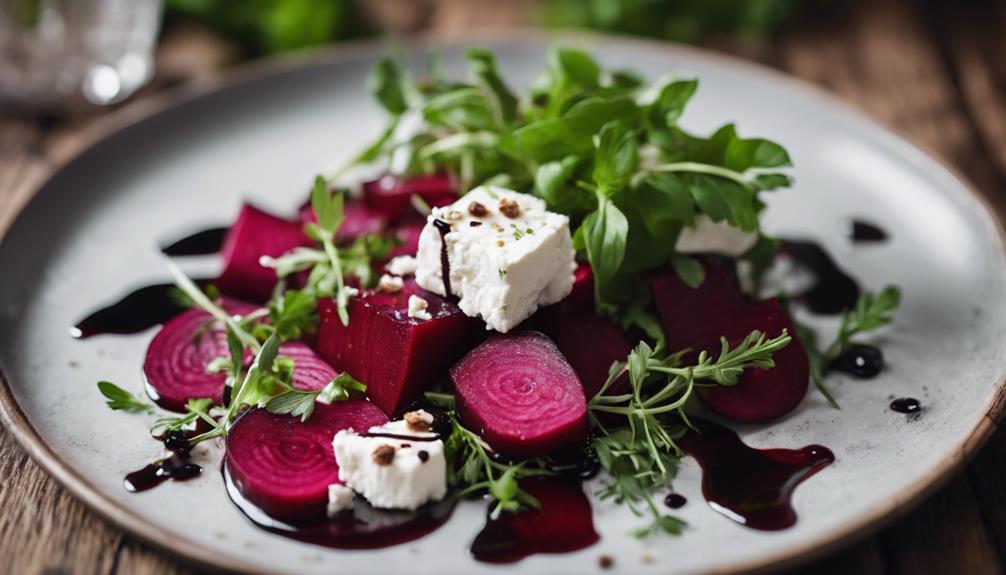
Consider the overall balance of flavors and textures in your Sous Vide Beet and Goat Cheese Salad to guarantee a satisfying dining experience. When reflecting on your culinary creation, pay attention to how the earthy sweetness of the beets complements the tangy creaminess of the goat cheese. The softness of the sous vide beets should contrast nicely with the crunchy texture of the nuts or seeds topping the salad. Additionally, think about how the acidic notes from a vinaigrette dressing can cut through the richness of the cheese, enhancing the overall taste profile.
For recipe variations, you can experiment with different types of cheese, such as feta or blue cheese, to add a twist to the traditional goat cheese option. You could also try incorporating roasted vegetables like carrots or sweet potatoes for added depth of flavor. Consider playing with various herbs and spices to elevate the dish further – perhaps a sprinkle of fresh dill or a pinch of smoked paprika for a unique touch. By exploring these variations, you can personalize the Sous Vide Beet and Goat Cheese Salad to suit your taste preferences and keep the dish exciting with each preparation.
Frequently Asked Questions
Can I Substitute Goat Cheese With Another Type of Cheese?
Yes, you can substitute goat cheese with other options like feta or blue cheese. They offer different flavors that pair well with beets. Experiment to find the cheese that complements your salad best.
How Do I Prevent Beets From Bleeding When Cooking Sous Vide?
To prevent beets from bleeding when cooking sous vide, make sure they're sealed tightly in a vacuum bag. This method maintains beet color and texture. Control cooking time and temperature precisely, keeping beets intact and vibrant throughout the sous vide process.
Can I Reuse the Sous Vide Cooking Liquid for Other Recipes?
You can definitely reuse the sous vide cooking liquid for other recipes. It's a great way to enhance flavors and boost your culinary creativity. Just strain out any solids before using it in different dishes.
Are There Any Alternative Cooking Methods for This Salad?
When making this salad, if you're seeking alternatives, consider roasting beets for a deeper flavor or grilling goat cheese for a smoky twist. Both methods can add a new dimension to your dish.
Can I Prepare This Salad in Advance and Store It for Later?
You can meal prep the salad in advance and store it for later. Make sure to keep it refrigerated properly. For flavor substitutions, consider using different types of cheese or adding a variety of nuts and seeds for added texture and taste.
Conclusion
To sum it up, sous vide beet and goat cheese salad is a delicious and elegant dish that showcases the natural flavors of these two ingredients. By cooking the beets at precise temperatures, you can lock in their nutrients and enhance their sweetness.
The creamy goat cheese adds a tangy contrast that complements the earthy beets perfectly. Experiment with different beet varieties and seasoning to create your own unique twist on this classic dish.
Enjoy the wonderful flavors and textures of this gourmet salad!
